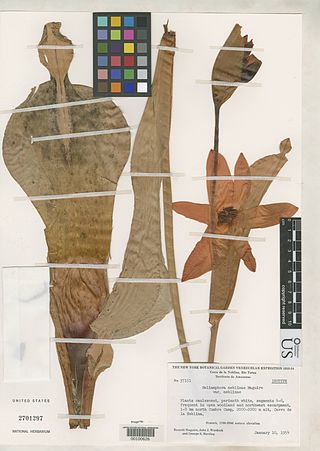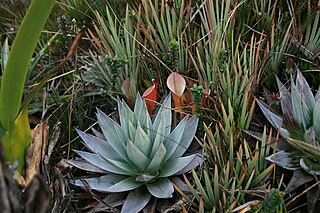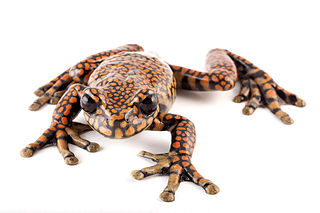
Hylidae is a wide-ranging family of frogs commonly referred to as "tree frogs and their allies". However, the hylids include a diversity of frog species, many of which do not live in trees, but are terrestrial or semiaquatic.

Pico da Neblina is the highest peak in Brazil, 2,995.3 metres (9,827 ft) above sea level, in the Serra da Neblina, part of the Serra do Imeri, a section of the Guiana Highlands on the Brazil-Venezuela border. As determined by a border survey expedition in 1962, its summit lies just within Brazilian territory, at a horizontal distance of only 687 m (2,254 ft) from the Venezuelan border at Pico 31 de Março. It is a common misconception to refer to this mountain as the highest point in South America outside the Andes while ignoring the Sierra Nevada de Santa Marta in Colombia.

Osteocephalus is a genus of frogs, the slender-legged tree frogs, in the family Hylidae found in the Guianas, the Amazon Basin, Venezuela, Colombia, southeastern Brazil, and north-eastern Argentina. Males are warty, while females are smooth.

Heliamphora hispida is a species of Marsh Pitcher Plant endemic to Cerro Neblina, the southernmost tepui of the Guiana Highlands at the Brazil-Venezuela border.

Heliamphora neblinae is a species of marsh pitcher plant endemic to Cerro de la Neblina, Cerro Aracamuni and Cerro Avispa in Venezuela. It is one of the most variable species in the genus and was once considered to be a variety of H. tatei. It is unclear whether or not there is a consensus regarding its status as a species, with at least a few researchers supporting the taxonomic revision that would elevate both H. tatei var. neblinae and H. tatei f. macdonaldae to full species status.
Myersiohyla is a genus of frogs in the family Hylidae. It was erected in 2005 following a major revision of the Hylidae and initially included four species that were previously placed in the genus Hyla. The genus is found in the tepui region of Guyana and Venezuela.

Ecnomiohyla, commonly known as fringe-limbed treefrogs or marvelous frogs, is a genus of frogs in the family Hylidae. This genus was erected in 2005 following a major revision of Hylidae. The ten original species in this genus were previously placed in the genus Hyla. The generic name Ecnomiohyla comes from Greek ecnomios and Hylas, the companion of Hercules.
Neblinichthys is a small genus of suckermouth armored catfishes native to South America.
Myersiohyla aromatica is a species of frog in the family Hylidae endemic to Venezuela. Known only from one tepuy, Cerro Huachamacari, its natural habitats are classed as subtropical or tropical moist montane forests and rivers.
Myersiohyla inparquesi is a species of frog in the family Hylidae. It appears to be endemic to the summit of Cerro Marahuaca, a tepui in central Amazonas state, Venezuela. Its natural habitats are tepui shrub and forests. Tadpoles live in fast-flowing streams.

Cerro Marahuaca, also spelled Marahuaka, is a tepui in Amazonas state, Venezuela. It has an elevation of 2,832 metres (9,291 ft) above sea level and is the second-highest mountain of the entire Guayana Shield. Cerro Marahuaca shares a common base with the much larger Cerro Duida and together they form the Duida–Marahuaca Massif. Both tepuis are located entirely within the bounds of Duida–Marahuaca National Park.

Cerro de la Neblina, also known as Serra da Neblina in Brazil and Sierra de la Neblina in Venezuela, is a sandstone massif located in the northern Amazon Basin. It is a tilted, heavily eroded plateau, with a deep canyon in its central portion, drained by the Baria River.

The natural range of the carnivorous plant genus Heliamphora is restricted to the southern Venezuelan states of Amazonas and Bolívar, and to adjacent portions of northern Brazil and western Guyana, an area corresponding to the western part of the Guayana Shield. These plants are largely confined to the summits and foothills of the sandstone table-top mountains of the region, known as tepuis.
Cerro Aracamuni is a granitic tepui in Amazonas state, Venezuela. Part of the Neblina–Aracamuni Massif, it lies north of Cerro Avispa and the vast complex of Cerro de la Neblina. Cerro Aracamuni and Cerro Avispa share a common slope area; they have a combined summit area of 238 km2 (92 sq mi) and an estimated combined slope area of 658 km2 (254 sq mi). Both of these cerro-plateaus have a maximum elevation of around 1,600 metres (5,200 ft).

The Serranía de la Neblina National Park is a national park of Venezuela.
Koyamaea is a monotypic genus of flowering plants belonging to the family Cyperaceae. The only species is Koyamaea neblinensisW.W.Thomas & G.Davidse.

Julianus is a genus of tree frogs in the family Hylidae. They are found in southeastern Brazil, Uruguay, and northeastern Argentina. This genus is considered poorly defined and is regarded by most to merely be a synonym of Scinax.
Myersiohyla neblinaria, the neblina tree frog, is a frog in the family Hylidae, endemic to Venezuela and possibly Brazil. Scientists have seen it between 1250 and 2100 meters above sea level.

Cophomantini is a tribe of frogs in the subfamily Hylinae of the family Hylidae, the true treefrogs.
Hyloscirtus sethmacfarlanei, commonly known as Seth MacFarlane's torrent frog, is a species of frog in the family Hylidae. It is endemic to forest habitats in Ecuador. It has been observed in the Machay Reserve on Cerro Mayordomo, at 2970 meters above sea level.











